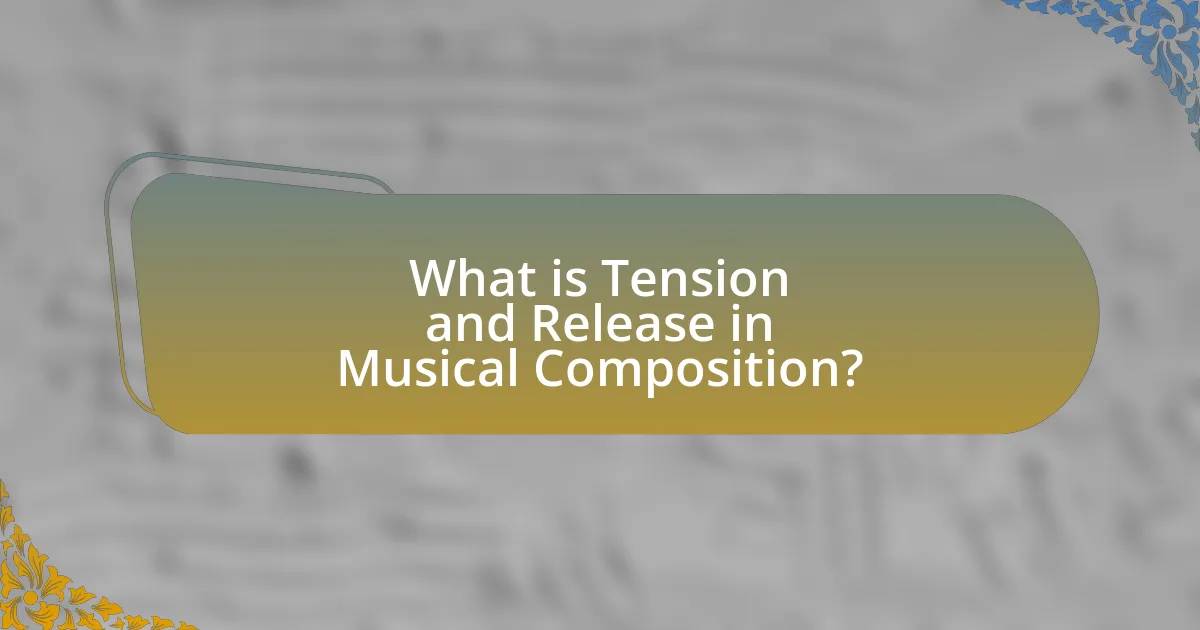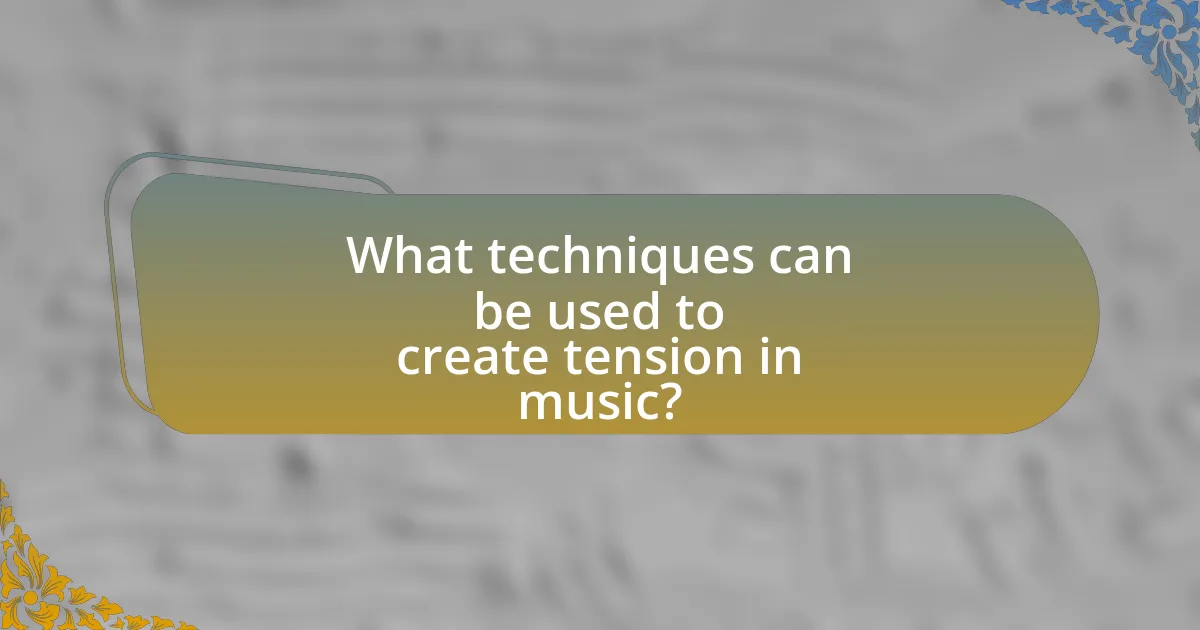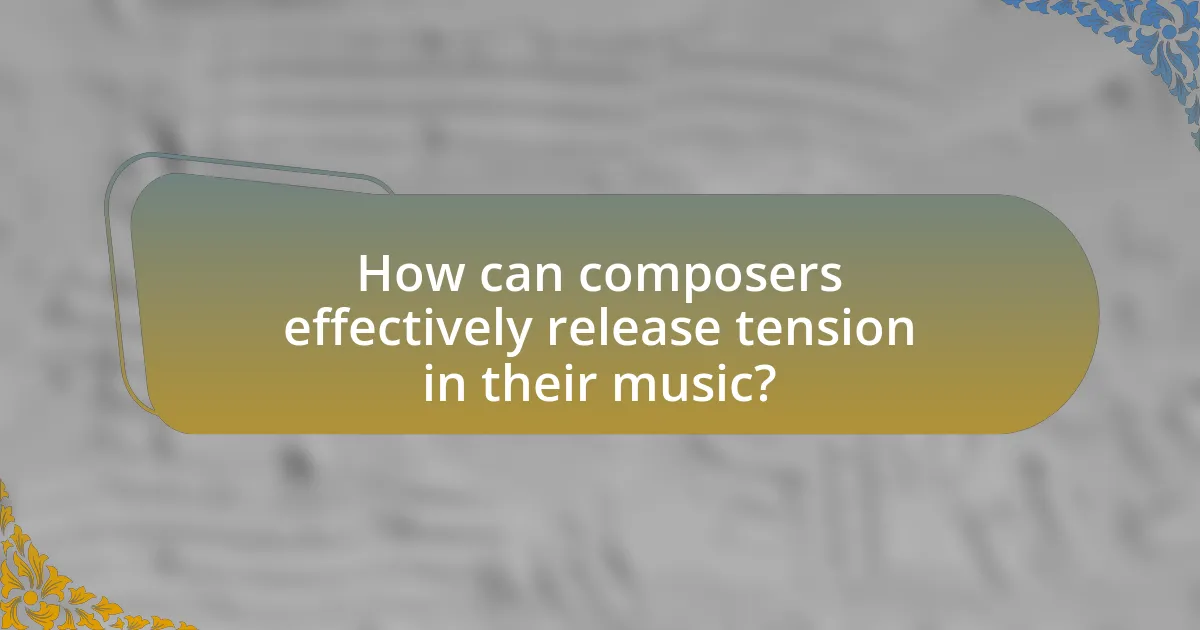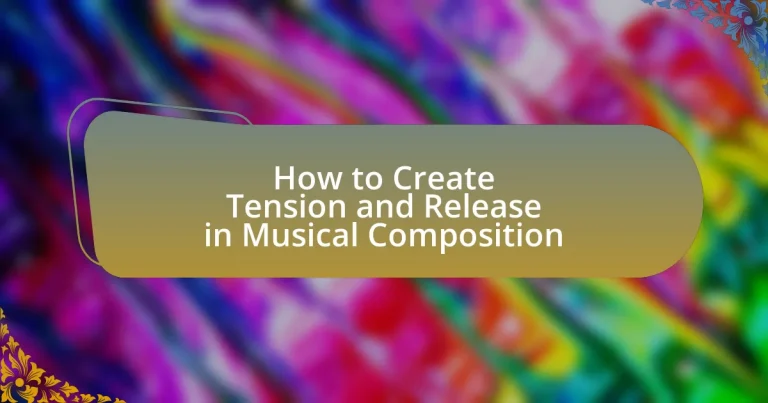Tension and release are essential concepts in musical composition that create emotional depth and listener engagement. This article explores how tension is generated through dissonance, rhythmic complexity, and dynamic contrasts, while release is achieved through consonance and resolution. Key techniques for creating tension include harmonic progression, syncopation, and variations in instrumentation, while effective release can be accomplished through resolving dissonance and utilizing dynamic shifts. The interplay of these elements not only enhances musical storytelling but also evokes strong emotional responses from listeners, making tension and release critical for impactful compositions.

What is Tension and Release in Musical Composition?
Tension and release in musical composition refers to the dynamic interplay between moments of heightened emotional or musical intensity (tension) and subsequent moments of resolution or calm (release). This concept is fundamental in creating emotional depth and engagement in music, as it guides the listener’s experience through contrasting musical elements. For example, composers often build tension through dissonance, rhythmic complexity, or unexpected harmonic progressions, which are then resolved through consonance, simpler rhythms, or predictable chord changes. This technique is widely recognized in various musical genres and is essential for maintaining listener interest and emotional impact.
How do tension and release function in music?
Tension and release in music function as a dynamic interplay that creates emotional impact and structure within a composition. Tension is generated through various musical elements such as dissonance, rhythmic complexity, and dynamic contrasts, which evoke a sense of anticipation or unease. Release occurs when these tensions are resolved, often through consonance, simpler rhythms, or softer dynamics, providing a sense of relief and satisfaction. This cyclical process is fundamental in music, as it guides listeners’ emotional responses and maintains their engagement. For example, in classical music, composers like Beethoven frequently employed this technique, using tension to build excitement before resolving it in a satisfying manner, thereby enhancing the overall narrative of the piece.
What are the musical elements that create tension?
Musical elements that create tension include dissonance, dynamics, rhythm, and harmonic progression. Dissonance arises when notes clash, creating an unresolved sound that heightens emotional intensity. For example, the use of minor seconds or augmented chords can evoke feelings of unease. Dynamics, such as sudden changes in volume, can also amplify tension; a sudden crescendo can lead to a climactic moment. Rhythm contributes to tension through syncopation or irregular time signatures, which disrupts the listener’s expectations. Harmonic progression, particularly the use of dominant chords leading to tonic resolutions, creates anticipation and a sense of longing. These elements work together to engage listeners and evoke strong emotional responses.
How does release manifest in musical composition?
Release in musical composition manifests through the resolution of tension created by harmonic, melodic, or rhythmic elements. This resolution often occurs when dissonant chords transition to consonant ones, providing a sense of closure and satisfaction. For example, in Western music, the movement from a dominant seventh chord to a tonic chord exemplifies this release, as it resolves the built-up tension. Additionally, the use of dynamics, such as a sudden drop in volume or a return to a softer section after a climactic build-up, further enhances the feeling of release. This technique is supported by the principles of music theory, which emphasize the importance of tension and resolution in creating emotional impact within a composition.
Why are tension and release important in music?
Tension and release are crucial in music because they create emotional dynamics that engage listeners. This concept allows composers to build anticipation and then provide satisfaction through resolution, enhancing the overall listening experience. For example, in classical music, composers like Beethoven often used tension through dissonance and then resolved it with consonance, which not only maintains interest but also evokes emotional responses. Research in music psychology indicates that tension and release can significantly affect listener enjoyment and emotional engagement, demonstrating their importance in effective musical composition.
What emotional responses do tension and release evoke in listeners?
Tension and release in music evoke a range of emotional responses in listeners, primarily feelings of anticipation, relief, and satisfaction. When tension builds through dissonance or rhythmic complexity, listeners often experience heightened emotional states, characterized by anxiety or excitement. This is supported by psychological studies indicating that unresolved musical tension can lead to increased arousal levels in the listener. Upon the release, typically achieved through consonance or resolution, listeners frequently feel a sense of relief and emotional catharsis, reinforcing the pleasure derived from the musical experience. Research by Huron (2006) in “Sweet Anticipation: Music and the Psychology of Expectation” highlights how these dynamics engage listeners’ emotions, confirming that the interplay of tension and release is crucial for creating impactful musical narratives.
How do tension and release contribute to musical storytelling?
Tension and release are fundamental elements in musical storytelling that create emotional depth and narrative progression. Tension builds anticipation and engages listeners by introducing conflict or uncertainty, often achieved through dissonance, dynamic contrasts, or rhythmic complexity. Release resolves this tension, providing satisfaction and closure, typically through consonance, softer dynamics, or simpler rhythms. This interplay mirrors storytelling techniques, where conflict leads to resolution, enhancing the listener’s emotional experience and connection to the music. For example, in classical compositions, composers like Beethoven and Wagner effectively utilized tension and release to evoke strong emotional responses, demonstrating its critical role in musical narratives.

What techniques can be used to create tension in music?
Techniques to create tension in music include the use of dissonance, dynamic contrasts, rhythmic complexity, and harmonic progression. Dissonance introduces clashing notes that evoke unease, while dynamic contrasts, such as sudden changes in volume, can heighten emotional impact. Rhythmic complexity, including syncopation or irregular time signatures, disrupts expectations and adds intensity. Harmonic progression, particularly through unresolved chords or modulation, creates anticipation for resolution. These techniques are widely recognized in music theory and practice, as evidenced by their application in various genres, from classical compositions to contemporary music.
How does harmony influence tension in musical pieces?
Harmony influences tension in musical pieces by establishing a framework of consonance and dissonance. Consonant harmonies create a sense of stability and resolution, while dissonant harmonies introduce conflict and unease, heightening emotional intensity. For example, in Western music, the use of dominant seventh chords, which contain dissonant intervals, generates tension that typically resolves to a tonic chord, creating a satisfying release. This relationship between harmony and tension is foundational in composition, as composers manipulate harmonic progressions to guide listeners through emotional landscapes.
What role do dissonance and consonance play in creating tension?
Dissonance and consonance are fundamental in creating tension in musical composition. Dissonance introduces instability and conflict, evoking feelings of unease, while consonance provides resolution and harmony, offering a sense of rest. The interplay between these two elements generates emotional dynamics; for instance, a dissonant chord can heighten anticipation before resolving into a consonant chord, creating a satisfying release. This technique is widely used in various musical genres, as evidenced by composers like Beethoven and Stravinsky, who skillfully manipulate dissonance and consonance to enhance dramatic effect and emotional depth in their works.
How can chord progressions enhance tension?
Chord progressions enhance tension by creating a sense of expectation and unresolved harmonic movement. For example, the use of dissonant chords, such as diminished or augmented chords, can evoke feelings of instability, prompting listeners to anticipate resolution. Additionally, progressions that move away from the tonic chord, such as a dominant seventh leading to a tonic, heighten tension by delaying the expected resolution. This technique is supported by music theory, which indicates that tension arises from the relationship between consonance and dissonance, as well as the functional roles of chords within a key.
What rhythmic elements contribute to musical tension?
Rhythmic elements that contribute to musical tension include syncopation, irregular meter, and polyrhythms. Syncopation creates unexpected accents that disrupt the regular flow of music, heightening emotional intensity. Irregular meter, such as 5/4 or 7/8 time signatures, introduces unpredictability, which can evoke feelings of instability. Polyrhythms, where two or more contrasting rhythms are played simultaneously, add complexity and tension by creating a sense of conflict within the music. These elements are widely recognized in various musical genres, including jazz and contemporary classical music, where they are employed to enhance dramatic effect and engage listeners.
How does syncopation affect the perception of tension?
Syncopation increases the perception of tension in music by disrupting the expected rhythmic patterns. When a strong beat is anticipated, syncopation introduces off-beat accents, creating a sense of surprise and unease. This rhythmic displacement engages listeners’ attention and heightens emotional responses, as evidenced by studies showing that syncopated rhythms are often associated with feelings of excitement and anticipation. For instance, research published in the Journal of Experimental Psychology found that participants rated syncopated music as more stimulating compared to regular, predictable rhythms. Thus, syncopation effectively enhances tension in musical compositions by challenging listeners’ rhythmic expectations.
What is the impact of tempo on tension in music?
Tempo significantly influences tension in music by altering the perceived urgency and emotional intensity of a piece. Faster tempos often create a sense of excitement and anxiety, heightening tension, while slower tempos can evoke calmness or melancholy, reducing tension. Research indicates that tempo affects physiological responses; for instance, studies show that faster tempos can increase heart rates and stimulate adrenaline, contributing to a heightened sense of tension. Conversely, slower tempos allow for more reflective moments, which can ease tension and create space for emotional release.

How can composers effectively release tension in their music?
Composers can effectively release tension in their music by utilizing techniques such as resolving dissonance, employing dynamic contrasts, and manipulating rhythm. Resolving dissonance involves moving from unstable chords to stable ones, which creates a sense of closure; for example, transitioning from a dominant seventh chord to a tonic chord provides a satisfying resolution. Dynamic contrasts, such as shifting from loud to soft passages, can also create a feeling of relief, as seen in Beethoven’s symphonies where sudden changes in volume enhance emotional impact. Additionally, manipulating rhythm, such as slowing down the tempo or introducing a pause, can heighten the sense of release, as demonstrated in many Romantic-era compositions where a ritardando leads to a climactic moment followed by a gentle resolution. These techniques are foundational in music theory and are widely recognized for their effectiveness in creating emotional depth in compositions.
What are common methods for achieving musical release?
Common methods for achieving musical release include resolving dissonance, utilizing dynamics, and employing harmonic progression. Resolving dissonance involves moving from tension-filled chords to consonant ones, creating a sense of relief; for example, a dominant seventh chord resolving to the tonic chord is a classic resolution in Western music. Utilizing dynamics, such as transitioning from a loud passage to a softer one, can also create a feeling of release, as it contrasts the intensity of the preceding music. Additionally, harmonic progression, particularly moving from a less stable chord to a more stable one, reinforces the sense of resolution, as seen in the common practice of moving from a subdominant chord to the tonic. These methods are foundational in musical composition, effectively guiding listeners through emotional landscapes.
How do resolution and cadence function in releasing tension?
Resolution and cadence function in releasing tension by providing a sense of closure and stability in musical phrases. Resolution occurs when dissonant chords move to consonant chords, creating a feeling of relief from tension. Cadence, which refers to the harmonic progression that concludes a musical phrase, reinforces this by signaling the end of a musical thought. For example, a perfect cadence (V-I) creates a strong sense of resolution, effectively resolving the built-up tension. This mechanism is essential in musical composition, as it guides the listener’s emotional journey, allowing for a satisfying experience through the contrast of tension and release.
What role does dynamics play in the release of tension?
Dynamics play a crucial role in the release of tension in musical composition by manipulating volume levels to create contrast and emotional impact. When composers use varying dynamics, such as crescendos and decrescendos, they build anticipation and then provide resolution, effectively guiding the listener’s emotional journey. For instance, a sudden drop in dynamics can create a sense of relief after a climactic build-up, reinforcing the feeling of tension release. This technique is supported by the principles of music theory, which emphasize the importance of dynamic contrast in shaping musical narratives and enhancing listener engagement.
How can contrast enhance the experience of tension and release?
Contrast enhances the experience of tension and release by creating distinct differences in musical elements, such as dynamics, rhythm, and harmony. These differences heighten emotional responses; for example, a sudden shift from a loud, dissonant passage to a soft, consonant one can evoke a sense of relief following tension. Research in music psychology indicates that listeners perceive tension and release more acutely when contrasting elements are employed, as demonstrated in studies by Huron (2006) in “Sweet Anticipation,” which highlights how expectation and surprise in music affect emotional engagement. Thus, the strategic use of contrast not only emphasizes the tension but also magnifies the subsequent release, enriching the overall musical experience.
What is the significance of contrasting sections in a composition?
Contrasting sections in a composition are significant because they create tension and release, essential elements for engaging the listener. By introducing different musical themes, dynamics, or rhythms, composers can evoke emotional responses and maintain interest throughout the piece. For instance, a shift from a loud, fast section to a soft, slow one can heighten anticipation and provide a satisfying resolution when the original theme returns. This technique is widely used in classical music, as seen in Beethoven’s symphonies, where contrasting sections enhance the overall narrative and emotional impact of the work.
How can variations in instrumentation contribute to tension and release?
Variations in instrumentation can significantly contribute to tension and release by altering the texture, dynamics, and emotional impact of a musical piece. Different instruments possess unique timbres and ranges, which can create contrasting layers of sound that heighten tension. For example, the use of strings can evoke a sense of urgency, while brass instruments can add power and intensity. Additionally, dynamic shifts, such as transitioning from a full orchestral sound to a solo instrument, can create a stark contrast that facilitates a release of tension. This technique is often employed in compositions to guide the listener’s emotional journey, as seen in works by composers like Gustav Mahler, who masterfully used instrumentation to build and resolve tension throughout his symphonies.
What are some best practices for balancing tension and release in compositions?
Balancing tension and release in compositions can be effectively achieved through the use of dynamics, harmonic progression, and rhythmic variation. Composers should utilize crescendos and decrescendos to create dynamic contrasts that heighten emotional impact, as seen in Beethoven’s symphonies where shifts in volume contribute to dramatic tension. Harmonic progression, such as moving from dissonance to consonance, can also establish tension and resolution; for example, the dominant to tonic resolution in Western music creates a satisfying release. Additionally, varying rhythm through syncopation or changing time signatures can introduce unpredictability, enhancing tension before resolving it with a return to a steady beat. These practices are supported by music theory principles that emphasize the importance of contrast in maintaining listener engagement.
How can composers assess the effectiveness of their tension and release techniques?
Composers can assess the effectiveness of their tension and release techniques by analyzing listener responses and emotional engagement during performances. This can be achieved through methods such as audience feedback, surveys, and focus groups, which provide insights into how well the tension and release are perceived. Additionally, composers can utilize music analysis software to evaluate structural elements, such as dynamics and harmonic progression, that contribute to tension and release. Research indicates that effective tension and release can enhance emotional impact, as demonstrated in studies like “The Role of Tension and Release in Music” by Huron (2006), which highlights the correlation between these techniques and listener satisfaction.
What common mistakes should be avoided when creating tension and release?
Common mistakes to avoid when creating tension and release in musical composition include failing to establish a clear tension-building process, neglecting dynamic contrast, and not resolving tension effectively. Establishing a clear tension-building process is crucial; without it, listeners may not feel the intended emotional impact. Neglecting dynamic contrast can lead to a flat listening experience, as variations in volume and intensity are essential for highlighting tension and release. Lastly, not resolving tension effectively can leave the audience unsatisfied, as a proper resolution is necessary to provide closure and emotional fulfillment in the composition.


